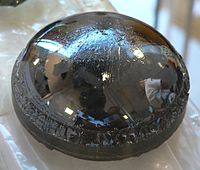
Photo from wikipedia
Abstract The incomplete nitriding and heterogeneity structure of large-size Si 3 N 4 -bonded SiC refractories limited its application in refractories industry. The objective of this work was to provide… Click to show full abstract
Abstract The incomplete nitriding and heterogeneity structure of large-size Si 3 N 4 -bonded SiC refractories limited its application in refractories industry. The objective of this work was to provide a way that adding carbon in matrix with the expectations of carbon could reacted with free-Si and transformed into SiC after nitridation. The effects of carbon sources on the bonded morphologies and nitridation process of Si 3 N 4 bonded SiC refractories were investigated. Results indicated the strength and Young’s-modulus of specimen with carbon black increased to 39.4 MPa and 103.89 GPa from 29.8 MPa and 73.43 GPa, respectively. The residual Young’s-modulus also improved from 44.13 GPa to 62.9 GPa after 9-quenching cycles. For specimen with graphite, residual graphite after nitridation resulted in a definite strength decline, but residual strength after quenching was improved. Moreover, analysis results on N-elements indicated surprisingly improvement in the nitriding degree for specimen with carbon black. The microstructure evolution and mechanism associating with the enhanced nitriding process was discussed.
Journal Title: Journal of The European Ceramic Society
Year Published: 2017
Link to full text (if available)
Share on Social Media: Sign Up to like & get
recommendations!